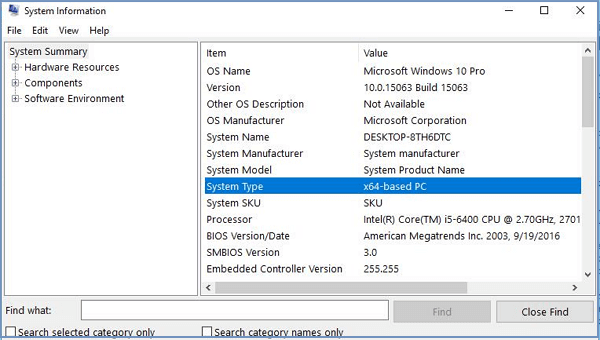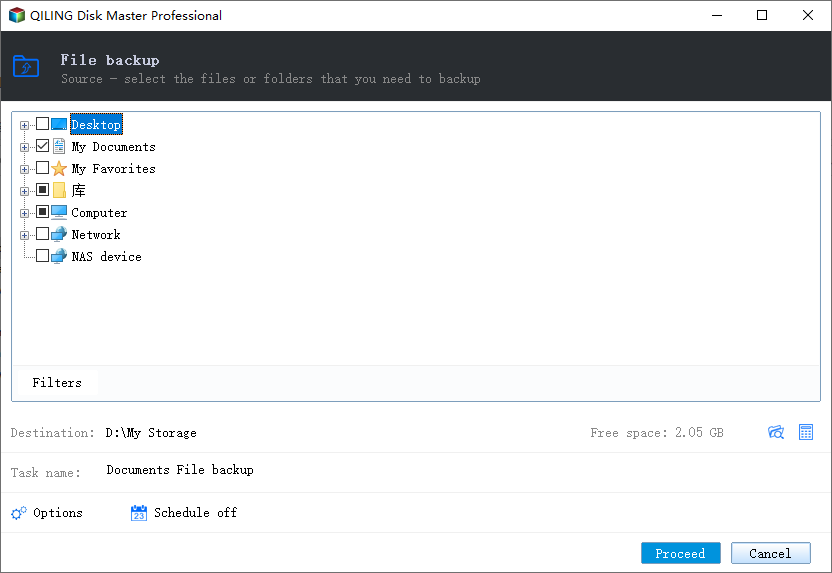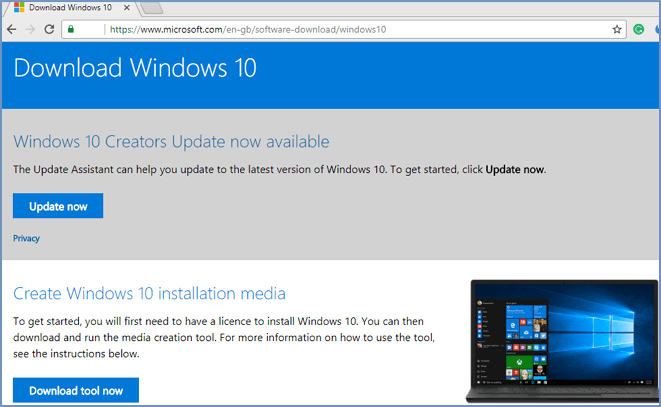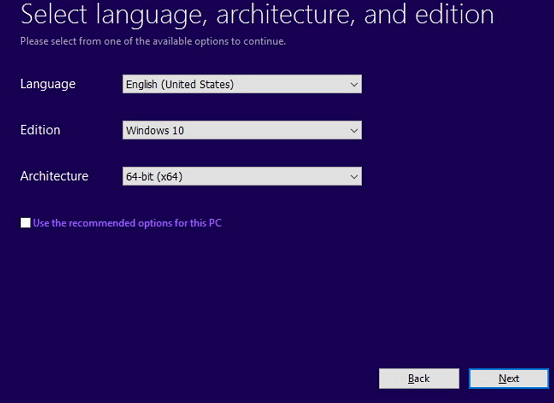Upgrade 32 Bit to 64 Bit in Windows 10 Without Losing Data
PAGE CONTENT:
- 1. Make Sure Your Processor is 64-Bit Capable
- 2. Back-Up Important Files Before Windows 10 64-Bit Upgrade
- 3. Upgrade to Windows 10 64-Bit
Microsoft gives you the 32-bit version of Windows 10 if you upgrade from the 32-bit version of Windows 7 or 8.1. But you can switch to the 64-bit version. Why upgrade windows 10 32 bit to 64 bit?
The reason is that the 32-bit version is limited to 4GB of RAM, which is a small amount. Especially when these days PCs usually have 8GB or more. If you upgrade your computer to 64 bit, you'll be able to run more applications simultaneously. Other applications like Google Chrome will be able to handle more open tabs, and you will be able to run more memory-intensive applications, such as AutoCAD, Photoshop, and video editing programs, etc.
However, during the period of changing to 64 bit, most people complain that their files got lost. Follow the three steps below to change Windows from 32 bit to 64 bit without losing data!
1. Make Sure 64-Bit is Compatible with Your Processor
You can only install the Windows 64-bit on compatible hardware, that is to say, you have to make sure if your computer has a 64-bit processor. Here we only provide the easiest way for you to check your system type:
- Open the "Start menu".
- Search for "System Information".
- Press "Enter".
- Look for "System Type".

Then, you will see one of the following system types:
1. 64-bit operating system, x64-based processor: Your CPU supports 64-bit and you have already installed the 64-bit version of Windows 10. So you don't need to upgrade.
2. 32-bit operating system, x64-based processor: Your CPU supports 64-bit, but you have installed the 32-bit version of Windows.
3. 32-bit operating system, x86-based processor: Your CPU supports 32-bit and you have installed the 32-bit version of Windows.
If you see the second type, then your computer can run a 64-bit version of Windows. If you see the third one, it means you can't install another architecture of the operating system because your CPU doesn't support it.
2. Back Up Important Files Before Windows 10 64-Bit Upgrade
To avoid data loss, you'd better make a full backup of your PC. While making a full backup of the computer can be time-consuming, we recommend you try a data backup utility - Qiling Backup, to finish this job quickly and effectively. This software enables you to make a full backup of your computer in one-click. It also helps you make backup schedules.
Download Qiling Backup and quickly making a backup of your important files.
Step 1: Open Qiling Backup and select "File backup" as the backup mode.
You may have a large amount of vital data to be protected as time goes on, such as documents, pictures, music, and videos, etc. It is always a good habit to have a backup on a regular basis. File Backup is one of the best choices for you to get over unexpected data loss.

Step 2: Select the files that you want to back up.
Tick the option at the top left corner named User Defined, you can browse to back up one or some specific file types on your computer or external storage device.

Step 3: Select a destination to save your backup file.
You'd better create the backup file in some other storage media or in some other drive. If not, there may be a risk of the backup file getting corrupted or destroyed.
Step 4: Click "Proceed" to execute your operation.
Notice:
If you want to keep all the apps or programs, it is a good idea to move/transfer programs to an external hard drive with Qiling backup. This PC transfer software moves data, applications, and accounts from one computer to another in Windows 10/8.1/8/7/Vista/XP. You can directly run programs from the external device without any difficulty. If you don't have an external hard drive, you can also use a USB with enough free space.
3. Upgrade Windows 10 32 bit to 64 bit
You'll need to perform a clean install to get to the 64-bit version of Windows 10 from the 32-bit one, for there's no direct upgrade path.
First, be sure to check that your current 32-bit version of Windows 10 is activated under Settings > Update & security > Activation.
Step 1. Create the installation media
1. Go to Microsoft's Windows 10 download page. Click the Download tool now button and save the Media Creation Tool on your desktop.

2. Connect a USB drive with at least 4GB of available space.
3. Double-click the MediaCrationTool.exe file.
4. Click the "Accept" to agree on the terms.
5. Select the Create installation media (USB flash drive, DVD, or ISO file) for another PC option. Click Next.
6. Uncheck the "Use the recommended options for this PC" option.
7. Make sure to select your language, edition, and, more importantly, the architecture, which in this case is 64-bit (x64). Click Next.

8. Select the USB flash drive option. Click Next.
9. Select the removable drive from the list. Click Next.
Step 2. Windows 10 32 bit to 64-bit install
1. Restart your computer and boot from the installation media ( press f2 when you restart > select boot > boot from USB).
2. On "Windows Setup," click the Next button.
3. Click "Install Now", and click the "I don't have a product key" link to continue.
4. Select the edition of Windows 10 (if applicable). This selection must match the edition of the license activates.
5. Accept the license terms and continue.
6. Click the Custom: Install Windows only (Advanced) option.
7. Select and delete system partitions - usually: Drive 0 Partition 1 and Drive 0 Partition 2.
8. Click Next and follow the instructions to install Windows 10.
When you finished the installation, Windows 10 will automatically check in with Microsoft and activate itself. You'll now be running the 64-bit edition of Windows on your PC. And you need to continue with the on-screen directions to finish the out-of-box experience (OOBE) to create a new account, set your preferences, and choose your preferred privacy settings.
Other Topics You May Like
- How to Create Windows To Go with Non-certified USB Flash Drive
- Create Windows 10 Backup System Image
- How to Copy/Clone Bootable USB Drive in Windows 10/8/7 (2021 Tips)
- How to Clone Windows 8 Hard Drive Easily Along with Operating System And Applications
- [Solved] This Application Was Unable to Start Correctly (Error Code: 0xc000007b)
Related Articles
- 4 Solutions to Active Partition Not Found in Windows 10
Find active partition not found in Windows 10? Read this article patiently to get effective solutions to the issue. A handy freeware is offered to backup Windows before errors occur. - P2V Windows 10 | The Simplest Way to Convert Physical to Virtual
P2V Windows 10 has plenty of benefits. But if you're not computer savvy, the process may seem complicated and confusing. Therefore, I'd like to provide a very easy solution to convert physical machine to virtual machine. - Windows 10 Backup 0 Bytes? Get Clear Ideas Here!
Are you confused with Windows 10 backup 0 bytes problem? Get clear ideas from this article. - How to Repair Windows 7 without CD Easily
Get clear ideas below and follow the stepwise guide to repair Windows 7 without CD. You have three choices, please check them and select one per your needs.